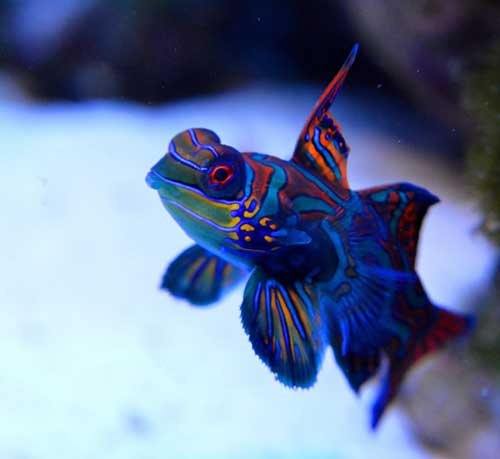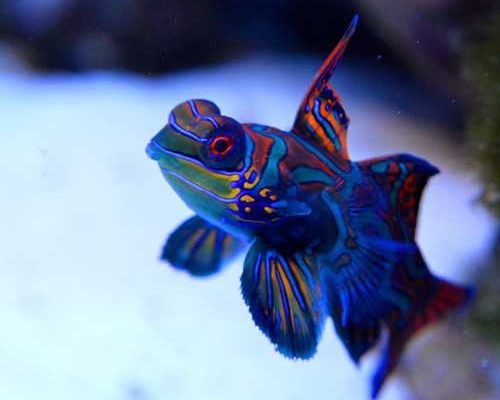
The Mandarin Goby, hailing from the warm waters of the Pacific, is not just pretty to look at — they also have distinct behavioral traits that can affect their care. These fish have personalities, preferences, and quirks. Understanding these aspects can help you create a thriving environment for your new aquatic friend. Think of it like getting to know a new buddy; the more you understand them, the better your friendship will be.
Understanding Mandarin Goby Behavior
Mandarin Gobies are known for their interesting behaviors that can often leave aquarists scratching their heads. These fish are naturally curious and explore their surroundings, often darting in and out of rocks and corals as if playing hide-and-seek. They’re not just about swimming aimlessly; they actively hunt for tiny invertebrates, which is a key part of their diet.
One of the standout behaviors of the Mandarin Goby is its territorial nature. They can be quite possessive of their space, especially males. If you’ve got a couple of males in close quarters, you might notice some squabbling over who gets to claim the prime hiding spots. But don’t worry; this behavior typically isn’t aggressive—it’s more of a dance for dominance. Providing plenty of hiding spots with rocks and corals can help mitigate territorial disputes.
Social Interactions
You might be wondering how Mandarin Gobies react to other fish in the tank. Honestly, they can be quite social creatures but exhibit a non-confrontational temperament. They tend to thrive in peaceful community tanks, especially when paired with other non-aggressive fish. However, be cautious with larger, more aggressive species; they might see the Mandarin Goby as an easy target.
If you’re adding a Mandarin Goby to your aquarium, consider their tank mates carefully. Smaller, peaceful fish are usually the best companions. Some common tank mates include:
- Clownfish
- Royal Gramma
- Small Wrasses
These combinations promote a harmonious environment where your Mandarin can explore and feel safe without being bullied.
Feeding Habits and Patterns
Feeding a Mandarin Goby can be one of the more challenging aspects of their care. These fish are natural foragers, spending their days hunting for tiny food particles. In the aquarium, they often require a specially tailored diet. They primarily eat copepods, small crustaceans that are essential for their health.
Creating a feeding routine is crucial. You might find they prefer to eat small meals throughout the day rather than a big meal once a day. Consider using a feeder or broadcast feeding method to simulate their natural foraging behavior. You can add live or frozen foods like brine shrimp or prepared foods designed specifically for them.
Keeping them well-fed will not only ensure their health but can also influence their behavior positively—happy fish are active and curious fish!
Stress and Comfort Levels
Stress can significantly impact the behavior of a Mandarin Goby, causing them to hide or become less active. It’s essential to create a comfortable environment for them. This includes maintaining stable water parameters and ensuring the tank has plenty of hiding spots.
If you notice your Mandarin Goby hiding too much, it might be a sign that something’s off. Monitor your water quality – things like temperature, salinity, and pH levels can affect their comfort. A well-maintained aquarium will help keep your fish feeling safe and secure, which translates into more active and engaging behavior.
Breeding and Reproductive Behaviors
If you’re lucky enough to have a pair of Mandarin Gobies, you might observe some unique breeding behaviors. These fish engage in a fascinating courtship dance to attract mates. The male displays vibrant colors and swims in looping patterns around the female. This ritual can be a stunning spectacle and a joy to watch.
Breeding in captivity can be challenging, but it’s not entirely impossible. Males and females will typically spawn in the early morning when water temperatures are stable. If you’re interested in breeding them, consider setting up a separate tank to provide them with a safe and calm environment where they can lay eggs without disturbances from other tank mates.
Common Behavior Problems
While Mandarin Gobies are largely peaceful, there are a few behavior problems you may encounter. As mentioned earlier, territorial squabbles can arise, particularly between males. If you see persistent fighting, you might need to separate them or add more hiding spots to diffuse tensions.
Another issue can be their tendency to stress in new environments. When first introduced to an aquarium, they might hide for extended periods. You can help ease the transition by dimming tank lights and ensuring the tank is well-planted and equipped with lots of caves and rocks for them to feel secure.
Finally, keep an eye on feeding habits. If they stop eating, it could be a sign of stress or illness. Regular observation will help you catch any changes in behavior early.
The behavior and temperament of the Mandarin Goby can be as colorful and dynamic as their appearance. By understanding their natural tendencies, you’ll be well-equipped to create a thriving environment that encourages their sociable and curious nature. These little fish have so much personality; taking the time to get to know them will enrich your aquarium experience.
Remember to pay attention to their behavior when introducing new tank mates, feeding routines, and overall habitat conditions. With a little care and attention, your Mandarin Goby will not only flourish but also become a beloved centerpiece of your aquatic world.

